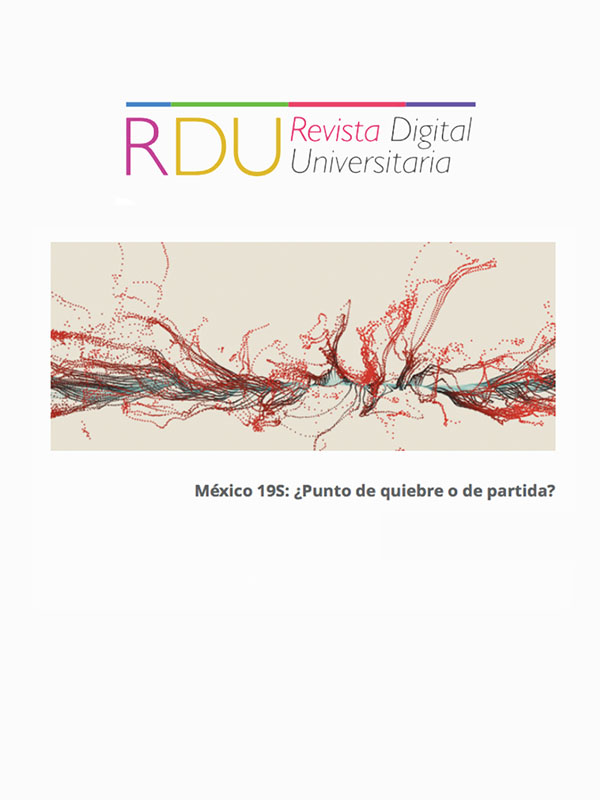Mexico 19S: Turning Point or Starting Point?
DOI:
https://doi.org/10.22201/codeic.16076079e.2017.v18n7.a0Keywords:
editorial, 19S, earthquakeAbstract
19S
Dear readers, I should have written this Editorial at the beginning of September, but the procrastination that often affects us led me to postpone sitting down in front of a blank page for several weeks—until 19S struck Mexico City. Now that I’m writing these lines, it’s impossible not to address the topic. To ignore it would be to disrespect the millions of people affected by the earthquake, the effects of which we are still processing.
In recent days, I’ve read dozens of editorials in the media that approach the topic from various perspectives. I’ll attempt to do so with sensitivity, without downplaying the importance of the lessons to be learned, and by situating some of the manuscripts featured in this issue of the Revista Digital Universitaria (RDU) within a framework of utility and optimism.
It’s fascinating how Charles Darwin captured in a few lines the brutal impact of just a few seconds on people’s lives and how this deep sense of insecurity emerges—a feeling that, as the quote states, “would never have arisen with hours of reflection.”
In a brief interval, the context of countless lives changed radically, and each day we ask ourselves how we can contribute our grain of sand to the vast horizon of possible actions. I firmly believe that educational and academic institutions, like ours, are in an ideal position to provide ideas and actions that foster a return to that fleeting and fluid state we call, for lack of a better word, “normalcy.”
References
INEE (International Network for Education in Emergencies). <http://www.ineesite.org/en/> (Accesado el 29 de septiembre de 2017).
Kannan, S. (2014) Improving Innovative Mathematical Model for Earthquake Prediction. J Geol Geosci, 3:168. doi:10.4172/2329-6755.1000168 <https://www.omicsonline.org/open-access/improving-innovative-mathematical-model-for-earthquake-prediction-2329-6755.1000168.php?aid=28150>.
Knopoff, L. (1996). Earthquake prediction: the scientific challenge. Proceedings of the National Academy of Sciences of the United States of America, 93(9), 3719–3720. <https://www.ncbi.nlm.nih.gov/pmc/articles/PMC39427/>.
Marr, B. (2015). Big Data: Saving 13,000 Lives A Year By Predicting Earthquakes? Forbes. <https://www.forbes.com/sites/bernardmarr/2015/04/21/big-data-saving-13000-lives-a-year-by-predicting-earthquakes/#2a91cdb5d8da> (Accesado el 29 de septiembre de 2017).
Marr, B. (ed) (2016) Terra Seismic: Using Big Data to Predict Earthquakes, in Big Data in Practice: How 45 Successful Companies Used Big Data Analytics to Deliver Extraordinary Results, John Wiley & Sons, Ltd, Chichester, UK. doi:10.1002/9781119278825.ch39 <http://onlinelibrary.wiley.com/book/10.1002/9781119278825>
National Geographic. Education. Teaching resources. Eartquakes 101. <https://www.nationalgeographic.org/media/earthquakes-101-wbt/> (Accesado el 29 de septiembre de 2017).
National Earthquake Hazards Reduction Program. <http://www.nehrp.gov/> (Accesado el 29 de septiembre de 2017).
Organización Mundial de la Salud. Acción Sanitaria en las Crisis Humanitarias. Terremotos. <http://www.who.int/hac/techguidance/ems/earthquakes/es/> (Accesado el 29 de septiembre de 2017).
Organización Panamericana de la Salud. Departamento de Emergencias en Salud. <http://www.paho.org/disasters/?lang=es> (Accesado el 29 de septiembre de 2017).
Shroder, J. (2014). In Chile’s earthquake, education was key to low mortality. Understanding how to cope with megaquakes is essential for survival. Elsevier Connect. <https://www.elsevier.com/connect/in-chiles-earthquake-education-was-key-to-low-mortality> (Accesado el 29 de septiembre de 2017).
Singh, D., Haraksingh, I. (2016) Earthquakes can be Predicted. J Geol Geophys, 5:255. doi:10.4172/2381-8719.1000255 <https://www.omicsonline.org/peer-reviewed/earthquakes-can-be-predicted-79790.html>.
Sneed, A. (2017). Can Artificial Intelligence Predict Earthquakes? Scientific American <https://www.scientificamerican.com/article/can-artificial-intelligence-predict-earthquakes/> (Accesado el 29 de septiembre de 2017).
UNESCO. Educación en Contextos Emergencia. <http://www.unesco.org/new/es/quito/education/educacion-en-emergencia/guias-para-docentes/> (Accesado el 29 de septiembre de 2017).
UNESCO. Tanah. Aplicación contra terremotos y tsunamis. <http://www.unesco.org/new/es/quito/education/educacion-en-emergencia/tanah-contra-los-terremotos-y-tsunamis/> (Accesado el 29 de septiembre de 2017).
Published
Issue
Section
License
Copyright (c) 2017 Revista Digital Universitaria

This work is licensed under a Creative Commons Attribution-NonCommercial-ShareAlike 4.0 International License.

Revista Digital Universitaria es editada por la Universidad Nacional Autónoma de México se distribuye bajo una Licencia Creative Commons Atribución-NoComercial 4.0 Internacional. Basada en una obra en http://revista.unam.mx/.










